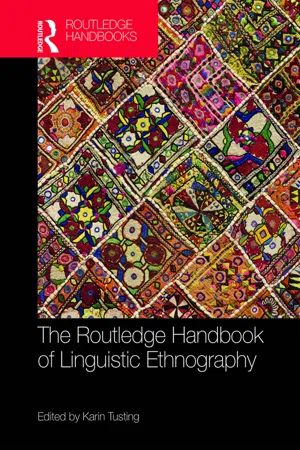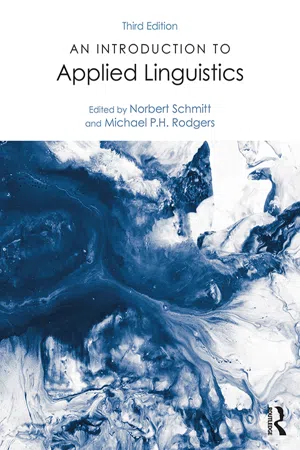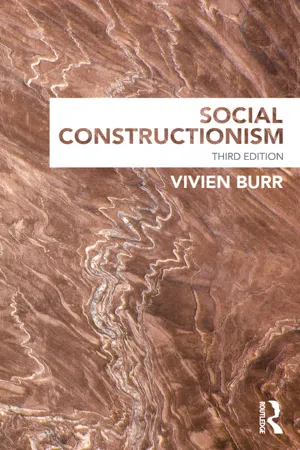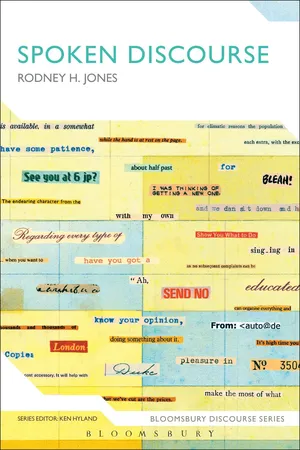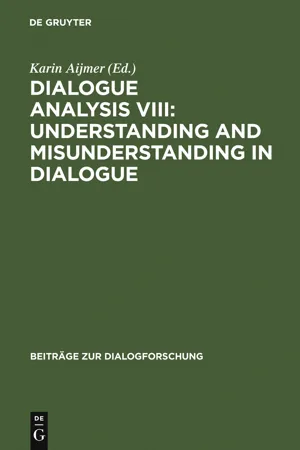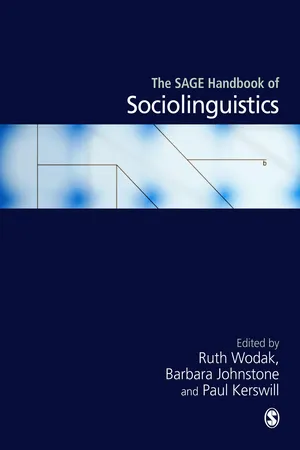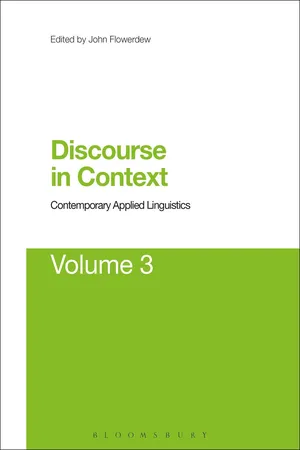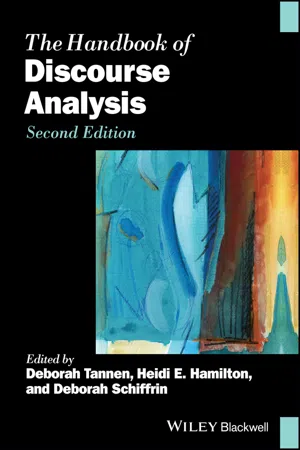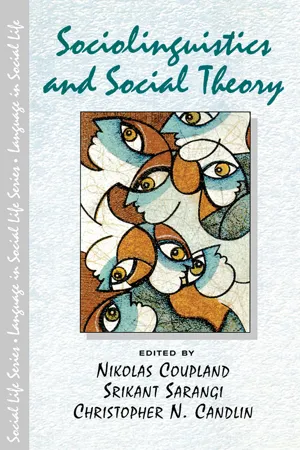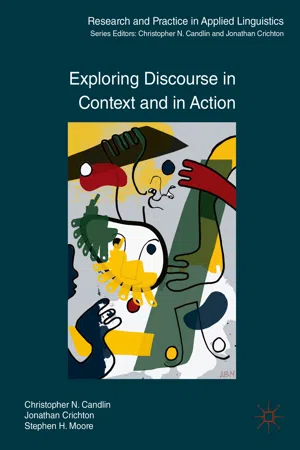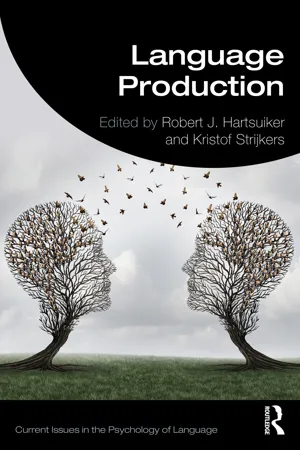Languages & Linguistics
Discourse
Discourse refers to the use of language in communication, encompassing both spoken and written forms. It involves the study of how language is used to convey meaning, shape social interactions, and construct knowledge. Discourse analysis examines the structure, patterns, and functions of language in various contexts, shedding light on the underlying cultural, social, and cognitive processes at play.
Written by Perlego with AI-assistance
Related key terms
1 of 5
11 Key excerpts on "Discourse"
- eBook - ePub
- Karin Tusting(Author)
- 2019(Publication Date)
- Routledge(Publisher)
One way to throw light on the term and concept is to examine how its use emerged, how the concept and tradition have been shaped historically, while recognising that the appeal of the discursive realm has mostly resided in the development of a particular agenda for language inquiry, at times complementary to developments in linguistics, and at other times in opposition with received practice at the time. Three defining, interrelated areas can broadly be identified in this regard.1 English translation: “Spoken public oratory which develops a particular topic.”2 English translation: “A spoken or written concrete actualisation of the abstract system of language.”- Viewed from within a linguistic project, ‘Discourse’ emerged in the 1960s and 1970s to refer to specific language phenomena which are characteristic of running text and ongoing interaction, in short, with a stress on authentic language data and on pushing formal and functional enquiry both beyond the bounds of the isolated grammatical sentence and the self-constructed language datum.
- From within a sociolinguistic and anthropological project, ‘Discourse’ has been instrumental in developing a qualitative research agenda on the role of language use in social life. In the background is an interactional and a performative view on language use in its complex manifestations. Language use is viewed as social action, and studying this is key to an understanding of its role in a larger project of understanding societies and cultures.
- Finally, as the term ‘Discourse’ also surfaced in social theoretical work, it has become a metaphor for capturing processes and practices of socio-cultural representation. In this view, representations are seen as imbued by world view, permeated by ideology, central to the construction of identities, and they often count as rationalisations of power relationships. This tradition descends from post-structuralist thought and deconstructivist traditions in critical enquiry.
Attending to the first area of definition, the development of a scientific object referred to as ‘Discourse’ resulted in a major breakthrough in linguistics’ efforts to unravel the nature of naturally occurring language use and to do so with specific reference to formal-functional properties characteristic of running text and ongoing interaction, as well as locating areas of meaning relative to situation, purpose and user. It is worth reminding readers here that some instances of early Discourse research prioritised the conversational domain of spoken exchanges, while other early developments focussed more on the properties of written texts. Anglo-American work, in particular, interacted directly with speech act theory and conversation analysis and was quick to integrate key concepts from these fields – e.g. turn, sequence, speech act, speaker intention, etc. At the same time, examples in this tradition such as Sinclair et al. (1972) on classroom interaction, Labov and Fanschel (1977) on psychotherapeutic encounters and Brown and Yule’s (1983) Discourse analysis textbook were still very much bracketed by fairly traditional linguistic concerns such as the detection of a hierarchical structure in speech events in ways akin to what had been described earlier for the constituents of the sentence. Corresponding continental European work, which often identified itself as ‘text linguistics’, focussed on descriptions of the functional components of structure beyond the sentence level and the ways in which textual make-up is tied to situation of use (e.g. anaphoric, cataphoric and situational reference; constituents of argumentative and rhetorical structure; devices to accomplish textual cohesion and establishing textual coherence, etc.), as well as on the cognitive processing of textual units. In each of these cases, the impetus was to push the linguistic agenda beyond the confines of the isolated sentence, locating the text in its contexts-of-use. Well-known examples include Harweg (1968) on reference, Werlich’s (1976) text grammar of English, De Beaugrande and Dressler’s (1981) identification of seven standards of textuality and Van Dijk and Kintsch’s (1983) work on the processing of textual information. - eBook - ePub
- Norbert Schmitt, Michael P.H. Rodgers, Norbert Schmitt, Michael P.H. Rodgers, David Coulson, Jonathon Clenton(Authors)
- 2019(Publication Date)
- Routledge(Publisher)
This will also give a good indication of the diverse demands on language faced by language learners: learning how to engage in Discourse is one of the most important goals in language learning and teaching. This means that the study of Discourse is absolutely central to the concerns of applied linguistics; and as a language student or language teacher it is very helpful to ‘develop an ear’ for Discourse – to learn to attend to the different strands of patterning in Discourse and to focus on those contexts and linguistic strategies that are most immediately relevant. Because of its pervasiveness in life, Discourse is studied in a number of different disciplines (see below). In the field of applied linguistics, the most relevant body of work is that which has come to be known as ‘Discourse analysis’ (or ‘text linguistics’). The Discourse analyst studies texts, whether spoken or written, whether long or short, and is interested in the relationship between texts and the contexts in which they arise and operate. Discourse analysts always look at real texts – and in this they differ significantly from formal (as opposed to functional) grammarians and philosophers of language, since these scholars tend to work with invented (constructed) examples. In addition, Discourse analysts study language independently of the notion of the sentence, typically studying longer passages of text, whereas grammarians traditionally do not work beyond the written sentence - No longer available |Learn more
- Vivien Burr(Author)
- 2015(Publication Date)
- Routledge(Publisher)
4 WHAT IS A Discourse? DOI: 10.4324/9781315715421-4As outlined in the previous chapter, when used by discursive psychologists the term ‘Discourse’ refers to an instance of situated language use. This is very often a conversation or other spoken interaction, but it can also be written texts of all kinds. Such spoken and written texts are analysed by discursive psychologists to examine the way that language is used in building successful accounts for the speaker or writer. The question underlying such analysis is typically one of process; the aim is to make visible how certain representations of events or persons are being achieved.When used by those taking a more deconstructionist stance, in what I am calling macro social constructionism, the term ‘Discourse’ has a somewhat different meaning, a meaning that extends its focus of interest beyond the immediate context in which language is being used by a speaker or writer. Whereas discursive psychology emphasises the capacity of the speaker to draw upon language as a cultural resource for his or her own ends, macro social constructionism emphasises the way that the forms of language available to us set limits upon, or at least strongly channel, not only what we can think and say, but also what we can do or what can be done to us. The use of the term ‘Discourse’ here, then, incorporates not just language but social practice too. As outlined in chapter 1 , this approach has been heavily influenced by the work of the French historian and philosopher Michel Foucault (see Box 4.1 ), and for this reason this analytic approach is often termedBox 4.1Michel Foucault (1926–84) was a French philosopher and historian of ideas, although he also had a background in psychology. He was especially interested in how power and knowledge are used as a form of social control through societal institutions. Foucault is often referred to as a poststructuralist and postmodernist, although he later preferred to characterise his work as a ‘critical history of modernity’. Some of his most well known works are The History of Madness, The Birth of the Clinic and The Order of Things, and these are examples of a method for analysing the history of ideas which he developed and called ‘the archaeology of knowledge’. He went on to publish The Archaeology of Knowledge, Discipline and Punish, and The History of Sexuality - eBook - PDF
- Rodney Jones(Author)
- 2016(Publication Date)
- Bloomsbury Academic(Publisher)
2 Studying spoken Discourse T he study of spoken Discourse is an interdisciplinary project that draws on fields such as linguistics, philosophy, anthropology, sociology and critical theory. While, different academic disciplines and the different approaches to Discourse that have grown out of them are often based on different assumptions about things like language, society and communication, one thing that unites all of the approaches to spoken Discourse that I will review in this chapter is a concern with action . Whereas linguists in the traditions of Saussure and Chomsky are primarily interested in language structures and how they are manifested in the way people speak, Discourse analysts start directly with the way people speak and investigate how that affects how they do things in the world. Below I will provide a brief survey of the different academic disciplines that have contributed to the study of spoken Discourse and the approaches that have grown out of them. I should mention straight off that there is a great deal of interesting work on spoken Discourse that I will fail to mention, and a lot of important ideas that will not find their way into this account. It is not, then, meant to be an exhaustive history of the study of spoken Discourse. Rather, what I hope to do is to put the ideas that I will develop in this book in both a disciplinary and a historical context and begin to explore the different epistemologies these ideas promote and the different analytical tools they make available to us. Linguistics Although I begin with the discipline of linguistics, it may come as a surprise to readers that, of all of the disciplines I will be discussing, this is not the one that has contributed the most to the study of spoken Discourse, and some linguists have even been downright hostile to many of the methods of studying spoken SPOKEN Discourse 26 Discourse that I will describe below. - eBook - PDF
Dialogue Analysis VIII: Understanding and Misunderstanding in Dialogue
Selected Papers from the 8th IADA Conference, Göteborg 2001
- Karin Aijmer(Author)
- 2011(Publication Date)
- De Gruyter(Publisher)
This view is fundamentally different from that adopted by critical Discourse analysts who maintain that language is only a part of Discourse. Discourse has been defined by Chouliaraki and Fairclough (1999: 38) as semiotic elements of social practices which includes language (written and spoken and in combination with other semiotics, for example, with music in singing), nonverbal communication (facial expression, body movements, gestures, etc.) and visual images (for instance, photographs, film). According to Fairclough (1995), Discourse, and any instance of discursive practice, is simultaneously a spoken or written language text, Discourse practice (i.e., text production and text interpretation), and sociocultural practice. Discourse analysis, therefore, goes beyond the description of the language text to include the interpretation of the relationship between the discursive practices and the text, and the explanation of the relationship between discursive practices and social practices. Kress (1998; cited in Fairclough 1999) argues that we should distance ourselves from the pri-macy of language in looking at the interplay between different semiotic systems, for ex-ample, in a science classroom, language figures in the Discourse just as one system among others, and is no more important than others. Whether language is seen as central or peripheral to the creation of meaning, and whether interactive talk is seen as central to the understanding of how social order is per-ceived by participants determine how investigations of Discourse are conducted. Linguistic Discourse analysis (LDA) and CA share the common characteristic of basing their descrip-tions firmly on hard evidence in the data and making their descriptions explicit, despite the fact that the phenomena that they are elucidating are quite different. - eBook - PDF
- Ruth Wodak, Barbara Johnstone, Paul E Kerswill, Ruth Wodak, Barbara Johnstone, Paul E Kerswill(Authors)
- 2010(Publication Date)
- SAGE Publications Ltd(Publisher)
Linguistic anthropologists ana-lyse cross-Discourse practices, that vary cross-culturally, involving, for instance, the violation of presumed universal maxims such as those entailed in Grice’s principle of cooperation (1975). Such investigations include among many others Ochs (1988) on Madagascar and Haviland (1997) on Tzotzil (Maya). In sum, critical social theories on the link between power and Discourse have made us aware of two core, underlying assumptions in particular. First, Discourse and power are co-constitutive. Discourse is constitutive of power by privileging certain perceptions of (social) reality and excluding others. Societal Discourses shape and sustain dis-criminatory and stigmatizing practices and, as such, bring about ‘disorders of Discourses’ (Wodak, 1996) in which some human beings are muted while the speaking authority of others is naturalized. Power relationships predispose which individuals are in a position to participate in and shape dis-courses. Secondly, however, Discourse is also seen as bearing emancipatory potential, being the place where power and authority might eventually be challenged and resisted. In general, therefore, language and communication as the primary dis-cursive practices are perceived as playing a critical role both in the perpetuation as well as the trans-formation of powerful Discourses. In the following, we will show how empirical sociolinguistic research has sought to exemplify these core assumptions. We have chosen some of the most prominent fields of research in contemporary sociolinguistics, i.e. studies on national identity and racism, social conventions (such as politeness), field linguistics and academic research, in order to show how the discipline of sociolinguistics has approached the interplay between power and Discourse. - John Flowerdew, Li Wei(Authors)
- 2014(Publication Date)
- Bloomsbury Academic(Publisher)
Other Discourse analysts (including in this volume) have employed various other levels of analysis in their consideration of context. There is no particular model which has been universally accepted. The model adopted very much depends on the analyst, the particular goals of the analysis and the context of the study (see below on the role of the analyst). Recently, sociolinguists and Discourse analysis have begun to consider how discursive processes operate across time and space, by appealing to the notion of sociolinguistic scales INTRODUCTION: Discourse IN CONTEXT 5 (Blommaert 2007, 2010) and how higher- and lower-level scales (times or spaces) can interact, sometimes leading to conflicting contexts, when, as a result of globalization, for example, traditional contextual features are merged with more contemporary ones. Shifts and layering of contexts are a particular feature of Harris and Rampton ’s chapter in this volume. Goodwin and Duranti (1992: 31) tell us that context and Discourse (they use the term talk ) are ‘mutually reflexive’, with Discourse shaping context as much as context shapes Discourse. van Dijk (2008a: 241) describes this mutually constitutive relationship as follows: [t]here is ongoing, dynamic mutual influence between talk or text and its production or comprehension on the one hand, and the way the participants see, interpret and construe the other “environmental” aspects of such Discourse, such as the setting, the participants, the ongoing action, as well as the goals and knowledge of the participants. This mutual reflexivity notwithstanding, there is a tendency in many examples of analysis to view context as shaping Discourse rather than vice versa. A more appropriate view, however, is of a continual shunting between text and context (Fairclough, Mulderrig and Wodak 2011).- eBook - PDF
- Deborah Tannen, Heidi E. Hamilton, Deborah Schiffrin(Authors)
- 2015(Publication Date)
- Wiley-Blackwell(Publisher)
While the study of sounds and sound patterns involves a variety of technical forms of analysis, it is nonetheless an important component of the consideration of political Discourse, and as we have seen above it is an area that deserves further consideration in terms of how it interfaces with other levels of discursive production. 6 Conclusions and Summary One of the core goals of political Discourse analysis is to seek out ways in which lan- guage choice is manipulated for specific political effect. In our discussion we have seen that almost all levels of language are involved, from sounds through lexis to pragmat- ics. Words, for example, can be used to gloss over negative perceptions, or to give a positive spin on events (Geis 1987; Johnson and Milani 2010; Silberstein 2004). In gram- mar, studies indicate how selected functional systems are manipulated to reflect spe- cific different ideological frames (Dirven, Hawkins, and Sandikciohlu 2001; Fowler and Marshall 1985). There are studies of pronouns and their distribution relative to political and other forms of responsibility (Allen 2007; Wilson 1990) and studies of the political role of pragmatic features like implicatures, metaphors, and speech acts (Chilton 2004; Harris, Grainger, and Mullany 2006; Holly 1989). Even the way politicians articulate their own names can have an impact on voters (Smith 1998). 788 John Wilson As mentioned, defining political Discourse is not a straightforward matter. Some analysts define the political so broadly that almost any Discourse may be considered political. At the same time, a formal constraint on any definition such that we only deal with politicians and core political events excludes the everyday Discourse of politics that is part of people’s lives. - eBook - ePub
- Nikolas Coupland, Srikant Sarangi, Christopher N. Candlin(Authors)
- 2014(Publication Date)
- Routledge(Publisher)
Sociolinguistics has largely dealt with the social and regional variation in the phonology, morphology and syntax of languages. That is, the starting point is in a conception of a language derived from linguistics, basically languages as sets of forms. This is one aspect of the legacy of linguistics. I would of course not argue that this legacy should simply be thrown overboard. But there are complementary and alternative approaches. From a sociocultural point of view, languages cannot be defined exclusively, or predominantly, in formal and grammatical terms (as unitary, for example national, languages and varieties thereof). Within activity systems, institutions, organisations and various other communicative communities, ‘social languages’ (Wertsch 1991) are largely defined in terms of their vocabularies, as opposed to their phonological and morphosyntactic properties, and the representations of the world(s) that they embody and are embedded within.8 Can we capture dynamics?Social, psychological, discursive, linguistic and physical realities are obviously characterised by both stability and change. Language can be seen as structure or as dynamic Discourse; in sociology we deal with both social structure and social action, in cultural studies with both culture and cultural practices. But the world view that dawns upon us when we consider how we look upon language is one in which stability is in focus, and dynamics is marginalised. It is a picture of a stable and shared world with some residuals of undetermined aspects to be contextually negotiated and determined in specific situated interactions. This structure-in-focus view posits a plethora of underlying structures beneath what on the surface appears to be more vague, ambiguous, changing and only partially shared.When we deal with social and cultural phenomena, and with language and Discourse, it is possible that we should reverse the focus-background relationships from the structure-in-focus view to a dynamics-in-focus view. That would involve an epistemology of dialogism (see for example Marková and Foppa 1990; Linell 1998b). We then assume, for example, that we live in a dynamic, only partially shared and fragmentarily known, dialogically constituted world, in which relatively stable features (such as those of language and social representations)16 - eBook - PDF
- Christopher N. Candlin, Jonathan Crichton, Stephen H. Moore(Authors)
- 2017(Publication Date)
- Palgrave Macmillan(Publisher)
Once again one can hear the resonance of this position in the work of Foucault, of Bourdieu, and in that of the ‘critical’ Discourse analysts Exploring Discourse in Context and in Action 203 such as Fairclough, all of whom have featured in earlier Themes and chapters of this book. 7.6 Some Further Examples of the Relationship Between Discourse and Identity 7.6.1 Language, Identity and Language Maintenance The connection between identity, language use and language maintenance and the procedures of social psychology are well exemplified in the work of the Canadian social psychologist Wallace Lambert. Lambert studied threats to the maintenance of French in French-speaking Canada by the way in which French-speaking Canadians saw themselves in relation to English-speaking Canadians, that is, how they felt about their identity as French speakers. As an apposite methodology he developed what he called the ‘matched guise’ technique, whereby subjects were exposed to the speech of fluent bilinguals reading aloud a reading passage in each of their languages (French and English). The study was designed so that the samples in each language were presented to subjects randomly within a much larger set of samples from a substantial number of speakers. In this way subjects did not realise that they were being exposed to two perfor- mances by the same speaker, one in each language, but assumed that the speakers were different individuals. Subjects were asked to evaluate the individual speakers in terms of a number of social and personality attri- butes. The study revealed that French-Canadian subjects tended unwit- tingly to evaluate a speaker more negatively when he or she was reading the passage in French than when he or she was performing in English. - eBook - ePub
- Robert J. Hartsuiker, Kristof Strijkers, Robert J. Hartsuiker, Kristof Strijkers(Authors)
- 2023(Publication Date)
- Routledge(Publisher)
11 Understanding Language Use in Social Contexts The Role of Past and Present Discourse Contexts Si On Yoon and Sarah Brown-Schmidt DOI: 10.4324/9781003145790-12 In this chapter, we discuss classic findings and new insights in the domain of conversational language use, with a focus on the types of contexts that shape language use in conversation. Language in conversation is inherently a social enterprise, involving an interactive exchange between two or more individuals, where the conversational partners may have repeated communicative interactions over time. As a result, conversational partners influence each other in terms of what they say and how they understand what was said to them. Conversation is also influenced by the context in which it occurs, where that context is broadly defined and can include the location (e.g., at a coffee shop), the time-period (e.g., right before a big exam), events and objects in the immediate environment (e.g., a loud espresso machine; a delicious assortment of pastries on the counter), as well as the conversational partners’ shared history (e.g., a prior conversation about where to find the best croissants in town). The mechanisms of conversational language use in social contexts where speech is unscripted have been largely unexplored due to the difficulties in examining this form of language use with classic psycholinguistic approaches. That said there is increasing interest in developing methods to examine unscripted language in more natural contexts where speakers can freely formulate utterances with fewer constraints (Bögels, 2020 ; Brown-Schmidt & Tanenhaus, 2008, Corps et al., 2022). In unscripted conversation, the presence of a conversational partner shapes the dynamics of language production, and as a result, the form of language is often quite different from traditional laboratory speech
Index pages curate the most relevant extracts from our library of academic textbooks. They’ve been created using an in-house natural language model (NLM), each adding context and meaning to key research topics.
